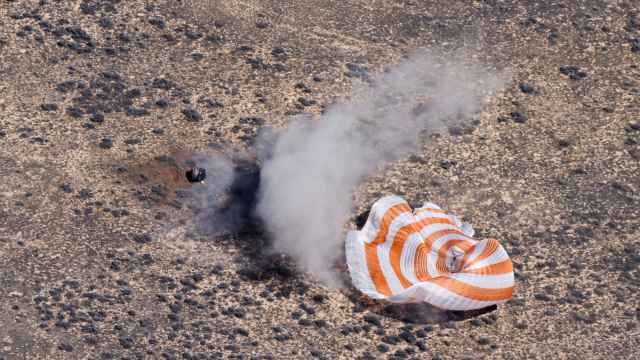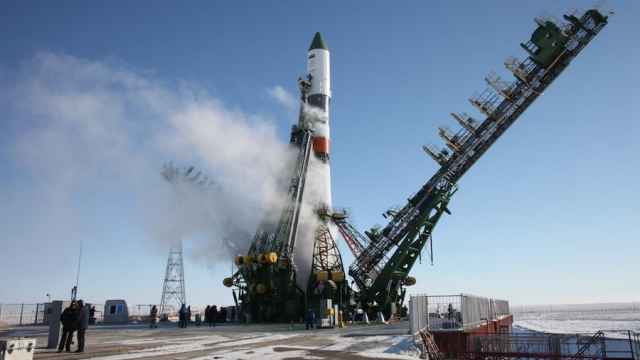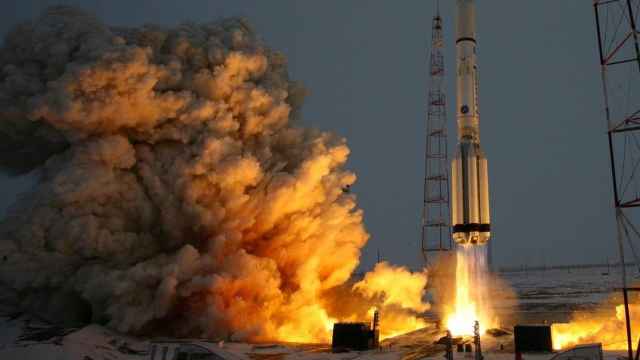This year's International Astronautical Congress, held in Guadalajara, Mexico, was a display of unbridled ambition. At an event for players in the global space race to demonstrate their vision of an increasingly cosmic future, SpaceX founder Elon Musk surprised no one when he stole the show, driving headlines around the world with a plan to colonize Mars.
But on the sidelines of the IAC, the Russian contingent had a surprise of its own: the country's most successful private airline, S7, is making a bid for the market Musk and other billionaires opened for private exploitation — commercial space launches. For a country that’s been a powerhouse in government-funded space activity, but fallen short with private endeavors, this is uncharted territory.
The “ticket” into the private space race, as S7 chief Vladislav Filyov put it, was a mothballed project from the late 1990s known as Sea Launch. Born of the post-Cold War reconciliation between East and West, the project was sunk in 2014 by a breakdown in relations between the project’s major partners — Russia, Ukraine, and the United States.
Sea Launch was, arguably, a project ahead of its time: a floating launchpad built to sail Ukrainian-Russian rockets to a spot on the equator, south of Hawaii. At that location, the Earth's spin provides a boost into space that helps cut costs and increase payload capacity. America's Boeing aerospace company eventually sold most of its shares to Russia's Energia space and rocket company, which landed a 95 percent stake in the project. In the end, Sea Launch went quiet.
The launchpad is still idle today, collecting barnacles and seaweed off a pier in Long Beach, California, but Filyov's S7 airline sees it as a unique opportunity. The Sea Launch project could become Russia's first private space launch company — the country’s answer to SpaceX. And Filyov snagged the hardware at a bargain price of just $150 million. All he needs to do, it seems, is provide the money to revive the platform.
“Why are we doing this?” Filyov told Bloomberg last month, “Just because it is beautiful.”
Head in the Clouds
In a country desperate to find modern heroes analogous to figures in the West, the Russian media has at times portrayed Filyov as a homegrown Richard Branson. Like the British entrepreneur, Filyov can be credited with breaking a national monopoly with his S7 airline — a company that has proven to be highly successful where competitors faded into oblivion.
However trivial, Filyov's marketing-savvy S7 has teased an appetite for space in the past. In February, a space-themed S7 advertisement went massively viral, with the help of alternative rock band and YouTube sensation OK Go. The promotion was simple enough: take a hip bunch of musicians famous for inventive videos, stick them in an airplane with S7 logos plastered on the walls, fly the plane along parabolic arcs to simulate zero gravity, and unleash a whole mess of paint-filled balloons. Hit the record button and voila!
But Filyov's formal entry into the private space market is significantly more involved than facilitating a music video. He plans to take Sea Launch out of mothball, and restore the launchpad to normal operations by 2018, using Energia as the main contractor. He says the platform can be used without upgrades for 15 years. In that time, S7 will service 70 launches.
S7’s plans for Sea Launch beyond 2030 remain a mystery. Whereas the likes of Musk and Amazon founder Jeff Bezos are investing in new technologies such as reusable rockets, it's not clear how Filyov can use Sea Launch to innovate or leave his mark on the private space race. But one unidentified source told the TASS news agency that S7 wants to build a commercial space station.
Grounded in Reality?
Russia’s only major privately-owned airline in the air-travel market today, S7 is financially well positioned for an out-of-this-world vanity project. S7 has zero debt, and in 2015 it raked in some $1.3 billion in revenue. Filyov told Bloomberg that the airline is paying cash for Sea Launch.
According to Russian space industry analyst Pavel Luzin, the Sea Launch venture isn’t exactly a shrewd business move. “It looks like S7 doesn't know what to do with its money,” he says.
Indeed, S7's acquisition of Sea Launch appears in some ways to be motivated by non-market considerations. The project was conceived in a considerably different environment, one in which the majority of customers were telecoms companies looking for cheaper alternatives to launch satellites into equatorial orbits. A floating launch platform is tailored specifically to suit these needs.
Today, similar services are rendered cheaply and efficiently by the likes of SpaceX, and even traditional state-owned monopolies like Russia's International Launch Services (still the largest operator on the market today).
“S7 is a bit late to the game if it intends to start a new launch service,” says Phil Smith, an aerospace market analyst at the Washington-based Tauri Group.
“Sea Launch only
launched three times a year during its operations from 1999 to 2014,
so its slice of [this market segment] was relatively small, and then
SpaceX entered the scene,” Smith says, adding that “there is now
a glut of launch providers — too much supply versus an average
global annual demand of 80 launches per year.”
Non-Market Motivations
One of the possible reasons that Filyov might be committing his successful S7 group to a potentially doomed space endeavor is to buy favor with an increasingly whimsical and suspicious political elite. Space is a traditional Russian enterprise, but it’s becoming more difficult to find government funding, given the country’s economic struggles. S7, on the other hand, has money.
“This bargain between S7 and Energia seems aimed at helping Energia financially,” says Luzin, “but it's not an act of mercy from S7. It's about S7's attempts to maintain good standing with the government. It's possible they were asked nicely to invest, or maybe S7 just wants protection. Energia is now part of the Roscosmos state space corporation, which is good protection.”
S7’s links to Energia are significant. In 2009, Sea Launch went into bankruptcy, and Boeing sold all but 5 percent of its stake, leaving Energia with responsibility for the project. The company would eventually have to suspend its operations in 2014, due to disruptions in supply of the Ukrainian-build Zenit rocket, which Sea Launch is designed to use.
Filyov says he is attempting to coax Ukraine's Yuzhmash to come back to the table. Its an offer that Yuzhmash's director has said is under consideration, but one that is ultimately vulnerable to the moods of officials in Kiev. If Yuzhmash doesn’t return, Filyov will need a new rocket, and Energia will be the contractor responsible for constructing it, likely at S7's expense.
But none of this really matters if Filyov's non-market motivations are simply unbridled optimism. It was this that drove the likes of Musk and his main billionaire-competitor, Jeff Bezos, to sink millions of their personal fortunes into what many in the media and expert community first derided as futile sci-fi projects.
“For us, acquisition of a space launch system is an entry ticket into the space industry,” Filyov said in an S7 statement. “Space infrastructure grows by leaps and bounds, and this is a very interesting line of business, the long-term outlook for which is good.”
While Filyov's path to space appears paved with good intentions, he faces one final, possibly insurmountable obstacle: the tandem between U.S. military-industrial giant Boeing and the U.S. State Department’s Directorate of Defense Trade Controls. Space technology has obvious military applications, and the United States guards the spread of rocket technology with particular jealously.
Energia and Boeing have yet to settle the score following their parting of ways in 2009. The American company has vowed not to approve the sale of Sea Launch until Energia and Yuzhmash pay Boeing some $350 million credited to the former Soviet enterprises to operate Sea Launch. Recent reports indicate the two parties are settling out of court, however.
Although Sea Launch
is essentially Russian and Ukrainian technology, and at this point
owned almost wholly by Russians, the project is by international
agreement under American control. This allows the State Department to
have its say. Filyov says the answer will come within the next six
months.
The timing isn’t
ideal, however. Given the tense relationship between Moscow and
Washington today, it’s not inconceivable that the United States
might choose to act as a spoiler.
A Message from The Moscow Times:
Dear readers,
We are facing unprecedented challenges. Russia's Prosecutor General's Office has designated The Moscow Times as an "undesirable" organization, criminalizing our work and putting our staff at risk of prosecution. This follows our earlier unjust labeling as a "foreign agent."
These actions are direct attempts to silence independent journalism in Russia. The authorities claim our work "discredits the decisions of the Russian leadership." We see things differently: we strive to provide accurate, unbiased reporting on Russia.
We, the journalists of The Moscow Times, refuse to be silenced. But to continue our work, we need your help.
Your support, no matter how small, makes a world of difference. If you can, please support us monthly starting from just $2. It's quick to set up, and every contribution makes a significant impact.
By supporting The Moscow Times, you're defending open, independent journalism in the face of repression. Thank you for standing with us.
Remind me later.






